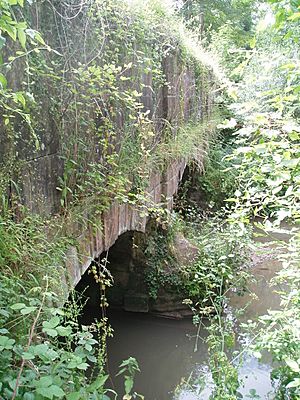Murtry Aqueduct facts for kids
Quick facts for kids Murtry Aqueduct |
|
|---|---|

The north face of Murtry Aqueduct
|
|
| Coordinates | 51°14′49″N 2°20′31″W / 51.247°N 2.342°W |
| Carries | Dorset and Somerset Canal |
| Crosses | Mells River |
| Locale | Great Elm |
| Maintained by | Dorset & Somerset Canal Society |
| Heritage status | Grade II |
| Characteristics | |
| Pier construction | Doulting Stone |
| Total length | 70 feet (21.3 m) |
| Water depth | 5.6 feet (1.7 m) |
| Longest span | 20 feet (6.1 m) |
| Number of spans | 3 |
| Piers in water | 2 |
| History | |
| Construction end | c.1795 |
The Murtry Aqueduct is a special bridge with three arches. It was built a long time ago to carry a canal, called the Dorset and Somerset Canal, over the Mells River. You can find it near Frome in Somerset, England. This aqueduct is also a 'Grade II listed building'. This means it's an important historical structure that needs to be protected.
Building the Aqueduct
This aqueduct was part of a plan for a new canal system. It was meant to be on an 8-mile long section of the canal. This section would have connected Frome to Nettlebridge. However, this part of the canal was never finished. In fact, the main canal itself was never even started!
Because the canal was never completed, the Murtry Aqueduct was never filled with water. It was built around 1795. Even though it was never used for its main purpose, it still stands today.
Design and Features
The Murtry Aqueduct has some interesting design details. For example, it has special decorative stones called 'rusticated spandrels'. These are the triangular parts above the arches. It also has flat, pillar-like shapes called 'pilasters' between each arch. These features make the aqueduct look more grand and important.
At one end of the aqueduct, there is a smaller arch. This is called a 'skew arch'. It runs underneath where the canal bed would have been. This special arch is on the south side of the aqueduct. However, it is separate from the main structure on the north side.

